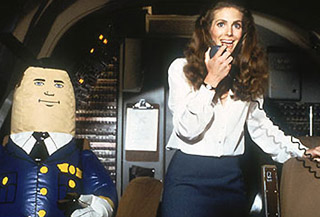|
|
Chapter Two: ZAZ (Not ZAZ)By Brett Ballard-BeachJanuary 19, 2012
1982 was a great year for William Shatner from a career standpoint: the hit summer film Star Trek II: Wrath of Khan was preceded by the launch of T.J. Hooker (to run for four years) in March on ABC and he capped it all with a breathlessly hysterical performance as Buck Murdock in Airplane II. Shatner only shows up in the final 20 minutes playing a counterpart on the moon to Bridges’ control room role back on Earth, but he grabs up all of the late laughs in the film. Having not followed his post-Star Trek ‘70s television work (and occasional feature film), I cannot vouch for whether this represents any kind of sea change from earlier performances, but he comes off as ruthless in his self-mockery, at one point delivering an extended rant on “blinking lights” that sounds like a Captain’s Log as rendered by a madman. It’s a terrific comic performance. As I have stressed, a lot of Finkleman’s script recycles gags and situations from the first film. It is a credit, then, to the strength of the ZAZ team that the jokes hold up, even in the wake of three decades of lame spoof wannabes, and perhaps to the fact that I hadn’t seen Airplane II a million times. But I credit him for the ridiculous plot and the very funny first act setup, which features one of the best uses of gratuitous breasts ever, two chuckle-worthy gags involving dogs, a mental hospital escape that evokes (for me anyway) the cover of Band on the Run, and Rip Torn back when he had a full head (and face) of hair. Later on, he manages to make winking nods to Star Trek, Star Wars, Mission: Impossible, and 2001 (he is the voice of the HAL-esque computer that goes haywire).
|

|
|
|

|
Friday, November 1, 2024
© 2024 Box Office Prophets, a division of One Of Us, Inc.


